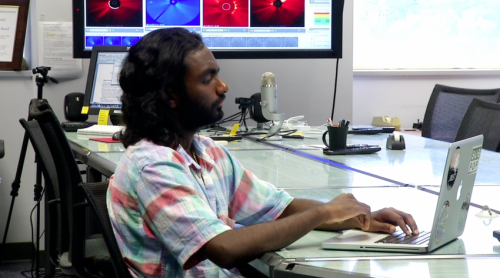On a daily basis, Dhaneshvaran Krishnarao monitors explosions on the sun that can cause magnetic solar storms near Earth. Credit: NASA
At times, the sun erupts, hurling a magnetic superheated cloud of gas toward Earth. Racing at thousands of miles per second, and hundreds of times bigger than the sun, this cloud of solar particles can cause a magnetic storm near Earth, disrupting satellite communications and—in worse case scenarios—overloading power transformers.
Here on Earth, Dhaneshvaran Krishnarao monitors satellite footage for this type of activity. He started at NASA in 2013 as a space weather forecaster after his professor at American University recommended the internship. Krishnarao returned to NASA's Goddard Space Flight Center in Greenbelt, Maryland, to continue his work this summer.
"We'll be looking at images, like x-ray data and UV data," Krishnarao said. "We monitor everything to see if something crosses a certain threshold. If it does, we would send out notifications for NASA robotic mission operators. Sometimes we respond to requests that the Air Force or other agencies would make to us."
Modern technology makes society more susceptible to the blackouts caused by solar storms. When struck by one of these huge clouds of solar material, called a coronal mass ejection, our planet's magnetic fields jostle back and forth. As the atmosphere changes, GPS satellite frequencies that must pierce the ionosphere now betray exact coordinates by a couple of yards. For airplanes, military operations, farmers' vehicles, and financial transaction that rely on GPS, this can prove devastating. Another type of eruption from the sun, called a solar flare, can interfere with shortwave radios. These low frequency radio waves use the ionosphere as a mirror to reflect transmissions around the globe; but during a solar storm, they simply disappear up into the sky—unable to bounce off of an atmosphere so changed by these storms.
Intern Dhanesh "DK" Krishnarao works in Code 674 on space weather forecasting under mentor Dr. Yihua Zheng.
But our technology also allows us to monitor these solar events and take necessary preparations. Goddard trains intern forecasters in a space weather boot camp for two weeks. During this orientation period, presentations and lecturers train the interns to study past space weather events so they would know how to respond to certain space weather events.
"I now forecast eight hours a week," Krishnarao said. "The rest of the time, I work on a project to use preexisting spacecraft to monitor solar conditions. This new system will allow mission operators to select a spacecraft and ascertain the likelihood of different risks occurring."
Krishnarao hopes to continue working in astrophysics and heliophysics in grad school. He found the environment at NASA conducive to his education.
"They're really pushing us and encouraging us," Krishnarao said of his mentors. "They are our friends."
Provided by NASA
























